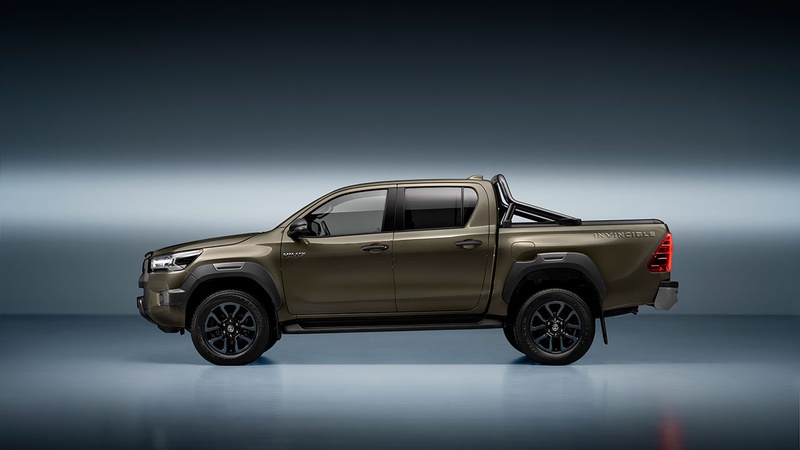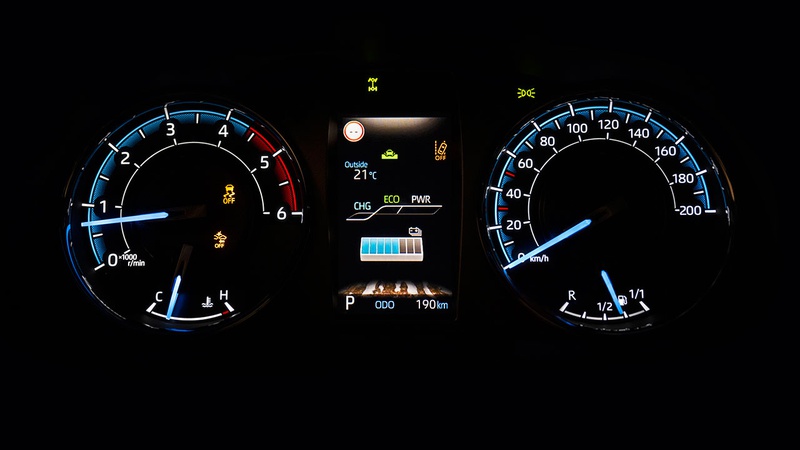The new powertrain variant adds a belt-integrated starter-generator to the Hilux's 2.8-liter four-cylinder diesel engine, with electrical power supplied by a 48V battery under the rear seat - weighing just 7.6kg - which charges during deceleration and braking.
The new Toyota Land Cruiser for European markets will also offer this system as an option when it goes on sale next year.
The hybrid system can contribute an additional 16 hp (12 kW) and 65 Nm under acceleration. Toyota has not said what impact this will have on the Hilux's 0-100 km/h time of 10.7 seconds, but it is not expected to make a noticeable increase in overall performance.
Instead, Toyota is highlighting a projected 5% increase in efficiency over the non-electrified diesel, a gain that's also helped by an improved stop-start system that keeps the engine off for longer when idling.
No figures have been released, but based on the pure diesel pickup's WLTP-certified 7.92 l/100 km, the new MHEV should be lower than 7.5 l/100 km.
This new system also makes for "more comfortable drive in traffic," Toyota claims, thanks to quicker throttle response and quieter starting.
Importantly, the company says the addition of these efficiency measures also improves the pickup's off-road capability, with the regenerative braking system working to improve stability on steep descents and the electric assist providing smoother acceleration on rough terrain.
The idle speed has also been reduced from 720 rpm to 600 rpm, which Toyota says makes the truck easier to control.
The company adds that special attention has been paid to waterproofing the new electrical components, so the Hilux Hybrid can still wade in water up to 700 mm deep. Towing capabilities are unchanged, with a maximum payload of 1000 kg and towing capacity of 3500 kg.
The new Hilux Hybrid 48V features the latest Toyota Safety Sense technology to provide drivers and other road users with world-class protection from a variety of potential hazards.







2024 Hilux Hybrid 48V
An enhanced Pre-Collision System (PCS) can better detect pedestrians at night, bicyclists during daytime, and oncoming vehicles or pedestrians at intersections when making turns. When such hazards are detected, the system issues audible and visual alerts before applying braking force if required.
An updated Lane Departure Alert (LDA) now detects the roadside in addition to painted lines, while Adaptive Cruise Control (ACC) with Road Sign Assist (RSA) allows the driver to quickly adjust the speed based on the current limit, and also slows the vehicle automatically before highway bends.
When driving at night, the Adaptive High Beam (AHB) function eliminates the need to switch headlight levels to avoid dazzling other drivers. It detects approaching vehicles and precisely adjusts the LED lights, dimming lamps to shield other road users and allowing the driver to use uninterrupted high beam for maximum visibility.
Inside the cabin, the latest Toyota Smart Connect system, complete with 8-inch screen, features cloud-based navigation with latest traffic information and interactive voice agent for hands-free operation of mobile phone calls, multimedia, air conditioning, electric windows and ambient lighting. Drivers also have the possibility to conveniently lock or unlock the vehicle and control the air conditioning via a smartphone app, depending on the grade. Apple CarPlay and Android Auto connectivity are now available wirelessly.



2024 Hilux Hybrid 48V
Pricing will be revealed closer to the Hilux Hybrid's mid-2024 launch date, but it will undoubtedly carry a small premium over the existing version.
Kwinten Sijs, senior manager for product marketing at Toyota Professional, said the mild hybrid does not pave the way for a plug-in hybrid version to rival the new Ford Ranger PHEV, but other alternative powertrain options are on the cards for the Hilux.
“We are acting and thinking as a multi-pathway [manufacturer] and that goes for all our models, including Hilux,” said Sijs. “It is of course a global model, so this needs to be considered during development.
“Currently, there is no concrete plan in terms of alternative powertrains on top of this one, but for sure that is something which is being considered. Maybe in the coming months, there will be a more concrete roll-out of alternative powertrains for Hilux. But currently we still have to go with the ICE (internal combustion engine) engine. It is a first, small step.”


